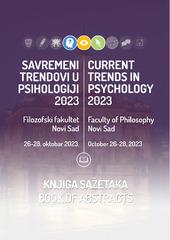Prikaz osnovnih podataka o dokumentu
Online violence among students at the University of Belgrade: results of the UniSafe survey
| dc.contributor | Kuzmanović, Dobrinka | |
| dc.contributor | Đikanović, Bosiljka | |
| dc.creator | Ćeriman, Jelena | |
| dc.date.accessioned | 2024-01-17T09:49:20Z | |
| dc.date.available | 2024-01-17T09:49:20Z | |
| dc.date.issued | 2023 | |
| dc.identifier.isbn | 978-86-6065-804-5 | |
| dc.identifier.uri | http://rifdt.instifdt.bg.ac.rs/123456789/3734 | |
| dc.description.abstract | Online violence research has exploded in recent years, but has largely focused on cyberbullying behaviours in primary and middle schools. Empirical research on online violence among students in higher education is much rarer not only in Serbia, but also worldwide. Given the negative consequences of online violence on young people's psychophysical health and well-being, it is important to know how many university students have experienced online violence with persons associated with their institution. The aim of this paper was to determine the prevalence and frequency of online violence among students in an academic context, taking into account gender and sexual orientation. Online violence can take many forms such as cyberbullying, online sexual abuse, non-consensual distribution of sexual images and texts. The survey is part of the international UniSafe project – the largest of its kind in Europe in the research sector, which investigates the prevalence of gender-based violence at universities and scientific research institutions in Europe. Quantitative data was collected through an online survey conducted in March and April 2022. The sample consisted of 2175 students from the University of Belgrade (76% female and 24% male; 87% heterosexual and 13% LGBT+). Тhe results indicate that the overall prevalence of online violence among students is 5%, among members of the LGBT+ population – 9%, heterosexuals – 4%, female students – 6%, male students – 4%. When it comes to specific forms of victimization, unlawful photographing or recording was reported by 2% of female and 3% of male and 2% LGBT+, 2% heterosexual; bullying, threats and attacks online was reported by 3% of female and 2% of male; 6% LGBT+, 2% heterosexual; offensive or threatening comments on learning or collaborative work platforms was reported by 2% of female and 1% of male; 4% LGBT+, 2% heterosexual. About half of the respondents (42%) had been a victim of online violence once, almost a third (30% students) 2-3 times and almost a fifth (15% of students) 6 times or more. No statistically significant differences in exposure to online violence were found in relation to gender and sexual orientation. Since starting their studies, 11% of students have noticed someone has been harassed online (e.g. via social media, email, messages or virtual learning platforms). More than two thirds (69%) reported that the victim was one or more girls, and about one fifth (23%) that it was one or more young men or a group of girls or young men. Compared with some previous research on online violence in Serbia, cyberbullying is less prevalent among university students than among high school students. The results of this study provides information on online violence at the university level, which has the potential to inform the development of more appropriate policies that include preventive and intervention measures. | sr |
| dc.language.iso | en | sr |
| dc.publisher | Filozofski fakultet, Univerzitet u Novom Sadu | sr |
| dc.relation | UniSAFE - European Union’s Horizon 2020 research and innovation programme under grant agreement no. 101006261 | sr |
| dc.rights | openAccess | sr |
| dc.rights.uri | https://creativecommons.org/licenses/by/4.0/ | |
| dc.source | Book of Abstracts -Current Trends in Psychology-, Faculty of Philosophy, Novi Sad October 26-28, 2023 | sr |
| dc.subject | online violence | sr |
| dc.subject | university students | sr |
| dc.subject | gender | sr |
| dc.subject | sexual orientation | sr |
| dc.subject | UniSafe project | sr |
| dc.title | Online violence among students at the University of Belgrade: results of the UniSafe survey | sr |
| dc.type | conferenceObject | sr |
| dc.rights.license | BY | sr |
| dc.citation.spage | 20 | |
| dc.citation.epage | 21 | |
| dc.type.version | publishedVersion | sr |
| dc.identifier.fulltext | http://rifdt.instifdt.bg.ac.rs/bitstream/id/13484/Book_of_abstracts_STUP_2023.pdf | |
| dc.identifier.rcub | https://hdl.handle.net/21.15107/rcub_rifdt_3734 |

